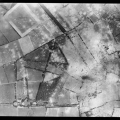Operation GOODWOOD
Sortie 16/RAF/0727 was intended to provide imagery for analysis of the accuracy and effect of the aerial bombardment which opened Operation GOODWOOD, the British armoured breakout from the Normandy beachheads during the Second World War. On 18th July 1944, three armoured divisions were to advance down a corridor to the east of Caen and break into the German defensive lines.
By chance, this sortie also captured the battle in progress.
Assault on Bourguebus Ridge
Counter-attack by King Tiger tanks
This imagery analysis was undertaken for NCAP by the late Mr Ian Daglish, a military historian. Imagery from NCAP features extensively in his book Over the Battlefield: Operation GOODWOOD, published in 2005. The book was produced following lengthy examination of aerial imagery in conjunction with contemporary accounts and official records.



